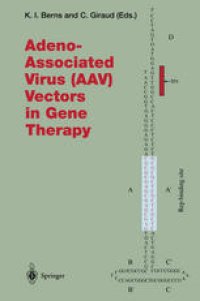
Ebook: Adeno-Associated Virus (AAV) Vectors in Gene Therapy
Author: K. I. Berns C. Giraud (auth.) Professor Kenneth I. Berns M.D. Ph.D. Catherine Giraud Ph.D. (eds.)
- Tags: Medical Microbiology, Virology, Cell Biology, Molecular Medicine
- Series: Current Topics in Microbiology and Immunology 218
- Year: 1996
- Publisher: Springer-Verlag Berlin Heidelberg
- Edition: 1
- Language: English
- pdf
Human gene therapy holds great promise for the cure of many genetic diseases. In order to achieve such a cure there are two requirements. First, the affected gene must be cloned, its se quence determined and its regulation adequately characterized. Second, a suitable vector for the delivery of a good copy of the affected gene must be available. For a vector to be of use several attributes are highly desirable: these include ability to carry the intact gene (although this may be either the genomic or the cDNA form) in a stable form, ability to introduce the gene into the desired cell type, ability to express the introduced gene in an appropriately regulated manner for an extended period of time, and a lack of toxicity for the recipient. Also of concern is the frequency of cell transformation and, in some cases, the ability to introduce the gene into nondividing stem cells. Sev eral animal viruses have been tested as potential vectors, but none has proven to have all the desired properties described above. For example, retroviruses are difficult to propagate in sufficient titers, do not integrate into nondividing cells, and are of concern because of their oncogenic properties in some hosts and because they integrate at many sites in the genome and, thus, are potentially insertional mutagens. Additionally, genes introduced by retroviral vectors are frequently expressed for relatively short periods of time. A second virus used as a vector in model systems has been adenovirus (Ad).
Viral vectors have been the favored delivery vehicle for gene therapy in recent years. Adeno-associated virus has become a candidate of great interest because of its biological properties which include site specific integration in human chromosome 19. In this volume methods of vector production and use in in vitro and in vivo experi- ments are described, including recent studies with hematopoietic stem cells and non-dividing cells. Various protocols for preparing recombinant AAV vectors and their intracellular delivery are extensively discussed. The first trial of AAV as vector for human gene therapy was conducted in late 1995.
Viral vectors have been the favored delivery vehicle for gene therapy in recent years. Adeno-associated virus has become a candidate of great interest because of its biological properties which include site specific integration in human chromosome 19. In this volume methods of vector production and use in in vitro and in vivo experi- ments are described, including recent studies with hematopoietic stem cells and non-dividing cells. Various protocols for preparing recombinant AAV vectors and their intracellular delivery are extensively discussed. The first trial of AAV as vector for human gene therapy was conducted in late 1995.
Content:
Front Matter....Pages I-IX
Biology of Adeno-associated Virus....Pages 1-23
The Roles of AAV Rep Proteins in Gene Expression and Targeted Integration....Pages 25-33
Packaging Systems for Adeno-associated Virus Vectors....Pages 35-50
The Challenges of Recombinant Adeno-associated Virus Manufacturing: Alternative Use of Adeno-associated Virus Plasmid/Liposome Complexes for Gene Therapy Applications....Pages 51-59
Adeno-associated Virus Vectors for Gene Therapy of the Hematopoietic System....Pages 61-73
Adeno-associated Virus Vectors for Gene Transfer into Erythroid Cells....Pages 75-91
Adeno-associated Virus 2-Mediated Transduction and Erythroid Lineage-Specific Expression in Human Hematopoietic Progenitor Cells....Pages 93-117
Development of Adeno-associated Virus Vectors for Gene Therapy of Cystic Fibrosis....Pages 119-144
Adeno-associated Virus Based Vectors As Antivirals....Pages 145-170
Back Matter....Pages 171-177
Viral vectors have been the favored delivery vehicle for gene therapy in recent years. Adeno-associated virus has become a candidate of great interest because of its biological properties which include site specific integration in human chromosome 19. In this volume methods of vector production and use in in vitro and in vivo experi- ments are described, including recent studies with hematopoietic stem cells and non-dividing cells. Various protocols for preparing recombinant AAV vectors and their intracellular delivery are extensively discussed. The first trial of AAV as vector for human gene therapy was conducted in late 1995.
Content:
Front Matter....Pages I-IX
Biology of Adeno-associated Virus....Pages 1-23
The Roles of AAV Rep Proteins in Gene Expression and Targeted Integration....Pages 25-33
Packaging Systems for Adeno-associated Virus Vectors....Pages 35-50
The Challenges of Recombinant Adeno-associated Virus Manufacturing: Alternative Use of Adeno-associated Virus Plasmid/Liposome Complexes for Gene Therapy Applications....Pages 51-59
Adeno-associated Virus Vectors for Gene Therapy of the Hematopoietic System....Pages 61-73
Adeno-associated Virus Vectors for Gene Transfer into Erythroid Cells....Pages 75-91
Adeno-associated Virus 2-Mediated Transduction and Erythroid Lineage-Specific Expression in Human Hematopoietic Progenitor Cells....Pages 93-117
Development of Adeno-associated Virus Vectors for Gene Therapy of Cystic Fibrosis....Pages 119-144
Adeno-associated Virus Based Vectors As Antivirals....Pages 145-170
Back Matter....Pages 171-177
....